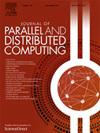定位动态环中的黑洞
IF 3.4
3区 计算机科学
Q1 COMPUTER SCIENCE, THEORY & METHODS
引用次数: 0
摘要
在支持移动代理的网络环境中,一个亟待解决的问题是存在对代理有害的网络站点。在本文中,我们考虑的是一个节点所带来的危险,它能摧毁任何进入的代理,而不留下任何痕迹。这种危险节点在文献中被称为黑洞(Bh)。在各种假设条件下,文献对同步和异步环境下系统代理团队确定其位置的问题(称为黑洞搜索(Bhs))进行了广泛研究。Bhs 的主要复杂度参数是解决问题所需的系统代理数量(称为规模);其他参数包括代理执行的移动次数(称为成本)和直到终止的时间。在现有文献中,除少数例外情况外,所有结果都基于一个共同假设,即网络是静态的,即其拓扑结构不会随时间发生变化。而我们考虑的是网络动态时的 Bhs:图的链接结构随时间变化。虽然时变图在过去二十年中一直是研究的热点,但人们对在这类网络中定位 Bh 的问题却知之甚少。在本文中,我们通过研究动态环网中的 Bhs,填补了这一研究空白,重点研究了 1 间隔连接对抗动态。问题的可行性和复杂性取决于很多因素,特别是环的大小 n、n 是否已知以及代理间通信的类型(白板、令牌、面对面、可视)。在本文中,我们提供了一个完整的可行性表征,介绍了大小最优的算法。此外,我们还建立了大小最优解的成本和时间下限,并证明我们的算法达到了这些下限。本文章由计算机程序翻译,如有差异,请以英文原文为准。
Locating a black hole in a dynamic ring
In networked environments supporting mobile agents, a pressing problem is the presence of network sites harmful for the agents. In this paper we consider the danger posed by a node that destroys any incoming agent without leaving any trace. Such a dangerous node is known in the literature as a black hole (Bh). The problem of a team of system agents determining its location, known as black hole search (Bhs ), has been extensively studied in the literature under a variety of assumptions, both in synchronous and asynchronous settings. The main complexity parameter of Bhs is the number of system agents (called size) needed to solve the problem; other parameters are the number of moves (called cost) performed by the agents, and the time until termination.
In the existing literature, with only a couple of exceptions, all results are based on a common assumption that the network is static, i.e. its topology does not change in time. We consider instead the Bhs when the network is dynamic: the link structure of the graph changes over time. While time-varying graphs have been the focus of intense research in the last two decades, very little is known on the problem of locating the Bh in such networks.
In this paper, we contribute to fill this research gap by studying Bhs in dynamic ring networks, focusing on the 1-interval connectivity adversarial dynamics. Feasibility and complexity of the problem depend on many factors, specifically on the size n of the ring, whether or not n is known, and the type of inter-agent communication (whiteboards, tokens, face-to-face, visual). In this paper, we provide a complete feasibility characterization presenting size optimal algorithms. Furthermore, we establish lower bounds on the cost and time of size-optimal solutions and show that our algorithms achieve those bounds.
求助全文
通过发布文献求助,成功后即可免费获取论文全文。
去求助
来源期刊

Journal of Parallel and Distributed Computing
工程技术-计算机:理论方法
CiteScore
10.30
自引率
2.60%
发文量
172
审稿时长
12 months
期刊介绍:
This international journal is directed to researchers, engineers, educators, managers, programmers, and users of computers who have particular interests in parallel processing and/or distributed computing.
The Journal of Parallel and Distributed Computing publishes original research papers and timely review articles on the theory, design, evaluation, and use of parallel and/or distributed computing systems. The journal also features special issues on these topics; again covering the full range from the design to the use of our targeted systems.
 求助内容:
求助内容: 应助结果提醒方式:
应助结果提醒方式:


